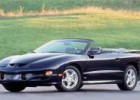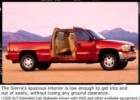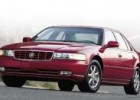Overview:
This weeks Tracker is great for those who want a sport utility type of vehicle at half the money of this very popular segment of the automotive market. I’ve heard a lot about the Toyota RAV4 as Tracker’s closest competitor and that is true enough from the Stats where they look like sisters.
The most significant difference is that the RAV4 has 4-wheel independent suspension and the Tracker has a rear live axle. Secondly is that, feature for feature, the RAV4 is about $2,000 more.
Background: Both are Mini Sport Ute’s and the Tracker replaced the discontinued Geo brand for the 1998 model year. In the early days of the Tracker it wasn’t even a mini utility in my view, but Chevrolet has taken it up against the competition and it is very strong. Tracker owners are under age 35, which is right where Chevrolet wants to be and they refer to it as “the sport utility for young-minded, adventurous, expressive buyers.” For off road use Tracker has a full ladder-type steel frame and nearly eight inches of ground clearance. I didn’t drive the convertible model, but I’ve heard the claim is true that folding top is specifically designed to be easy to raise and lower. Trackers are built in Canada by CAMI, Inc., a joint venture of General Motors and Suzuki, which also sells this vehicle as the Suzuki Vitara.
The 1999 Chevrolet Tracker is available in four trims: a 2-door convertible in 2WD or 4WD, a 4-door hardtop in 2WD or 4WD.
The 4-door 4-wheel drive model I tested was well equipped and at the top end of the price schedule. I truly enjoyed driving the vehicle and haven’t tested many of the mini utilities. They have become a player in this segment of the market, and I think folks will appreciate the added fuel efficiency. I also believe they won’t get their knickers in a twist over the obvious trade off of less power and performance of their larger, more luxurious relatives.
If you have money to burn, these Mini’s won’t excite you. But for the cost conscious who share the desire to own a Sport Utility, this is just the ticket. And considering that over 75% are used in town anyway, the lack of size and power will never become an issue. I think we Americans tend to buy more than we really need. Gas prices here in the US have been much lower than the rest of the world so we haven’t paid much attention to making them better. We go for big and heavy probably because we can. The rest of the world is far more practical. I think that mindset will change in the future.
If you’re budget won’t justify a $30,000 sport utility, you can opt for a mini utility from the list below for half the dough, or buy two, one for you and one for your better half.
The competition:
Honda CR-V $18-20K, Isuzu Amigo $15-20K, Jeep Wrangler $14-20K, Subaru Forester $18-22K, Suzuki Grand Vitara $13-19K, Toyota RAV4 $15-17K, Kia Sportage $14-18K.
Good News:
Clean lines, car-like comfort, affordable, good gas mileage
Bad News:
Limited space, lacks power
Standard Equipment:
2.0 liter 4-cylinder 127 horsepower engine, 4 speed automatic trans, dual airbags, daytime running lights, child safety locks, 4-wheel anti-lock brake system (ABS), AM/FM stereo, rear-seat heater ducts, fuel tank skidplate, power steering and Scotchgard protection, shift-on-the-fly 4WD system and automatic locking hubs, air conditioning, tilt steering wheel.
Gas Stats:
22 City and 25 Highway MPG.
Pricing:
MSRP $15,935





